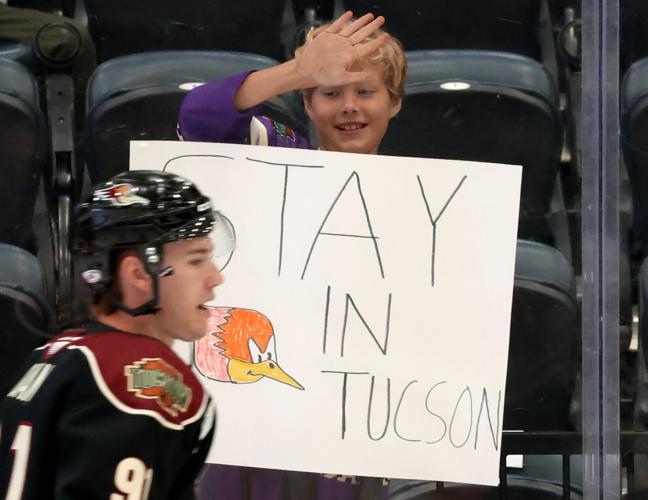Nashville’s local government and the state of Tennessee voted last year to subsidize a new stadium for the NFL’s Tennessee Titans at a record level — $1.26 billion.
It was the first public subsidy for a stadium to top $1 billion, but not the only recent record.
The city of Worcester, Massachusetts, is spending around $90 million of the cost of a new stadium housing the Boston Red Sox Triple-A minor-league team. It’s considered a record-expensive minor-league stadium, at a total of about $160 million.
Whenever I hear of these cases, I cringe. Public officials often say these deals pay for themselves in the long run, through increased tax revenue and spending in the area. It’s rarely if ever true, and the owners are generally undeserving.
But in Tucson, the Rio Nuevo tax-increment financing district may have found a rare subsidy that is almost matched by revenues, in its pitch to keep the Tucson Roadrunners here: $240,000 per year for up to three years.
It’s a minor-league subsidy for a minor-league city. Not desirable, in that it gives back a little money to the owners of a franchise, the Arizona Coyotes, who don’t need it and who, by most accounts, failed in Phoenix.
But the deal, which the Tucson City Council still must approve, won’t cost us much, and it will forestall the flight of what has been one of the more successful efforts at professional sports in Tucson history.
You may recall some of Tucson’s many pro-sports flameouts. In hockey alone, the Mavericks, Icemen and Rustlers came and went before Jimmy Carter left the White House. Then came the Gila Monsters, which averaged 1,000 fans per game over a season and a half, and the Scorch, which folded before the team played a game.
That doesn’t even count all the minor-league baseball teams who have come and gone.
When the Roadrunners showed up, there were reasons for cynicism — pro teams have trouble competing against the Arizona Wildcats for Tucsonans’ attention and money.
But there were also reasons for hope. Notably, conflicts between the city of Tucson and Rio Nuevo, which gets a portion of state sales tax revenue from a central Tucson area, were resolved in 2013.
Then Rio Nuevo started pouring money into fixing up the convention center, especially the arena. They put another $3.2 million into new locker rooms, bathrooms and other facilities before the first puck was dropped in October 2016.
And in 2019, $65 million more in spending was approved, including $3 million for a new ice plant at the arena. Some of this spending was expected to be recouped through a $2 per ticket fee going to Rio Nuevo. At an average 4,000 fans per game, times 36 games, that fee produces about $288,000 per season.
It’s not enough to recoup the cost of the hockey-related renovations, but it’s significant money over a 10-year lease.
As time went on, the Roadrunners did pretty well, although I didn’t help — never making a single game. This is weird for a Minnesota-raised kid who grew up with hockey, married to a woman who played hockey, but so it goes.
This last season, the Roadrunners averaged more than 4,000 fans per game — low for the American Hockey League, but good for a pro team in Tucson.
If you were downtown on game night, the people in hockey jerseys were there, walking around, spending a little money. On April 19, the evening of the second-to-last regular season game, I was in The Monica restaurant on Congress with friends, where some fans were eating, and we struck up a conversation.
They warned me to come to one of the next games or likely miss my chance forever. Still, I missed the last regular-season game and the playoffs.
As it turned out, nobody really knew what was going to happen with the Roadrunners. Alex Meruelo, the billionaire owner, mishandled the team and couldn’t even fill the 5,000-seat Mullett Arena in Tempe for the last Coyotes season.
When Meruelo said offhandedly that he planned to move the Roadrunners to Tempe, Tucson officials started working to stop it from happening. There was no extortionate demand that Tucson pay up or they’d move, just an acknowledgment that the Roadrunners were in flux.
Fletcher McCusker, the long-time chair of the Rio Nuevo board, was of course one who responded. The Roadrunners are the Tucson Arena’s steadiest clients. Losing them would be a financial blow, and a letdown, although the Roadrunners would have to pay a few million to break the lease.
The offer that Rio Nuevo made was to pay half the rent and office costs of the Roadrunners — about $240,000 per year. As it turns out, that is quite close to the sales tax revenue directly produced by the Roadrunners — around $226,000 per year.
“We basically just rebated that back to them,” McCusker said.
But Rio Nuevo also gave up the $2 per ticket fee that helps pay back the cost of TCC renovations. And that definitely hurts.
It hurts, especially because there’s no reason the owners need this money. They can afford to pay their own costs in full. Of course, that also means they can afford to pay the $3 million to $4 million estimated to be the price of breaking the lease.
In general, the penalties should probably be higher for breaking leases — otherwise, teams are known to threaten to break them in order to win concessions from governments. The city should consider this if negotiations begin again in the next two or three years.
But still, we’re talking about a minor-league deal here — a net loss in the $14,000-per-year range on the office-and-rent subsidy, plus the fees worth around $288,000 a year. The principle of it hurts, but it’s nothing like the pricey stadium deals that officials have so much trouble resisting.





